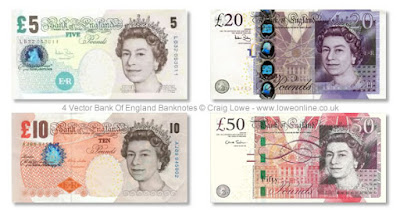GBP £
The british pound is specific to just the united kingdom despite being in europe the uk have continued to keep there births pound, there are only 4 notes in the brittish currencies and 8 coins, the coins are shaped differently from one another this makes the value easy to differenciate alongside this the notes are also in a similar way to the coins although more specifically ordered by size the £5 note is by far the smallest of the set, each note gradually increases in size.
USD $
Next up is the American Dollar, this is considerably larger than the brittish currency having approx 7 bank notes and 7 coins, the dollar unlike the british currency features a $100 dollar bill and a $1 & $2. The bank notes themselves have previous and past presidents on, including the coins. Unlike most bank notes the american dollar is made out of cotton most notes are infact made out of paper this is the long run will be more sustainable meaning the dollar will infact last longer.
YEN
The YEN is the national currency for Japan, the YEN is one of the only currencies to have people such as writers, scientist etc. this is a sign influence and encouragement and even empowerment of talent. The YEN features some buildings and scenery from Japan unlike many other notes just focusing on 'people' or 'monarchs'. Japan is well known for its beautiful scenery, they are also well known for there philosophy of elements 'fire' 'water' 'wind' and 'earth' this could be shown on the current note although the appearance is archaic meaning there is cetainly room for improvement. Similarly the coins are also widely different from other currencies with some coins featuring centres removed.
EURO
The euro is bi-country currency, this currency was appointed after the adjointment of europe - although there are country specific changes, one thing I have noticed about the bank notes for the euro is the theme of arches, one other thing I have also noticed unlike other currencies there are infact no people on either the coins or the notes, this simply highlights structure and places possibly showing the connections and bridges between paths in europe? I don't know it is up to your personal interpretation I guess but I can see a connection deffinatly between the notes and arches!
FRANC
The franc unlike other currencies is very bright and colourful, this currency stood out to me for this one particular reason, the currency is similar to the euro - could this currency of had an effect on the design of the euro? after all the Franc is french, well one type is as it is also used in Switzerland and Liechtenstein this particular franc is swiss. "All banknotes are quadrilingual, displaying all information in the four national languages. The banknotes depicting a Germanophone person have German and Romansch on the same side as the picture, whereas banknotes depicting a Francophone or an Italophone person have French and Italian on the same side as the picture. The reverse has the other two languages." There is much contrevesy in the note due to the capping.
KRONA
The Krona which translates to the Crown - Is the native currency for Iceland. The first Krona was introduced in 1874 which replaced the rigsdaler. The icelandic coins are by far my favourite out of the currencies the coins feature fish/mamals found in ice lands water such as dolphins, crab and cod. I like the concept of celebrating their wildlife.
RUPEE
The ruppee is currently used as currency in India. india were one of the first countries to use coins in there currency, India were not allowed to print paper/cotton money until 1861, the first note was then printed in 1917. For the visually impaired on each note is a printed raised shape, this helps people who are visually impaired to pay with the right money.This can also be said for coins too:
Delhi mint - dot
Mumbai mint - diamond
Hyderabad mint - star
Kolkata mint - No mint mark
Bitcoin
The bit coin is a digital currency. It is all completely virtual there are no printed 'money' I personally don't understand the btcoin and how it has value - I also find it very insecure because of it being purely digital if this is the future of money I still need fourth explanation - the video below should share some insight.
There are many more in the world but these specifically are more used currencies in the world/ or previously used.
Sources:
http://www.fleur-de-coin.com/eurocoins/banknotes
http://everything.explained.today/Euro_banknotes/
http://jpninfo.com/4625
http://www.thejapanguy.com/the-japanese-yen/
http://www.euro-dollar-currency.com/euro_bill.htm
https://www.oanda.com/currency/iso-currency-codes/FRF
http://famouswonders.com/swiss-franc/
















No comments:
Post a Comment